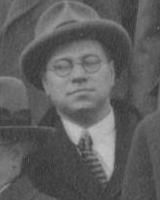
In abstract algebra, a generating set of a group is a subset such that every element of the group can be expressed as the combination of finitely many elements of the subset and their inverses.

In mathematics, a group G is called the direct sum of two subgroups H1 and H2 if
In the theory of abelian groups, the torsion subgroupAT of an abelian group A is the subgroup of A consisting of all elements that have finite order. An abelian group A is called a torsion group if every element of A has finite order and is called torsion-free if every element of A except the identity is of infinite order.
In abstract algebra, a free abelian group or free Z-module is an abelian group with a basis. Being an abelian group means that it is a set with an addition operation that is associative, commutative, and invertible. A basis is a subset such that every element of the group can be found by adding or subtracting basis elements, and such that every element's expression as a linear combination of basis elements is unique. For instance, the integers under addition form a free abelian group with basis {1}. Addition of integers is commutative, associative, and has subtraction as its inverse operation, each integer is the sum or difference of some number of copies of the number 1, and each integer has a unique representation as an integer multiple of the number 1.

In abstract algebra, a finite group is a group, of which the underlying set contains a finite number of elements.
In group theory, a locally cyclic group is a group in which every finitely generated subgroup is cyclic.

In mathematics, the Frattini subgroup Φ(G) of a group G is the intersection of all maximal subgroups of G. For the case that G has no maximal subgroups, for example the trivial group e or the Prüfer group, it is defined by Φ(G) = G. It is analogous to the Jacobson radical in the theory of rings, and intuitively can be thought of as the subgroup of "small elements". It is named after Giovanni Frattini, who defined the concept in a paper published in 1885.
In abstract algebra, a module is indecomposable if it is non-zero and cannot be written as a direct sum of two non-zero submodules.

In algebra, a finitely generated group is a group G that has some finite generating set S so that every element of G can be written as the combination of finitely many elements of the finite set S and of inverses of such elements.
In group theory, a branch of mathematics, a torsion group or a periodic group is a group in which each element has finite order. All finite groups are periodic. The concept of a periodic group should not be confused with that of a cyclic group.

In mathematics, specifically in group theory, the Prüfer p-group or the p-quasicyclic group or p∞-group, Z(p∞), for a prime number p is the unique p-group in which every element has p different p-th roots.
In mathematics, in the field of group theory, a locally finite group is a type of group that can be studied in ways analogous to a finite group. Sylow subgroups, Carter subgroups, and abelian subgroups of locally finite groups have been studied. The concept is credited to work in the 1930s by Russian mathematician Sergei Chernikov.
In mathematics, especially in the area of algebra studying the theory of abelian groups, a pure subgroup is a generalization of direct summand. It has found many uses in abelian group theory and related areas.
In mathematics, in the field of abstract algebra, the structure theorem for finitely generated modules over a principal ideal domain is a generalization of the fundamental theorem of finitely generated abelian groups and roughly states that finitely generated modules over a principal ideal domain can be uniquely decomposed in much the same way that integers have a prime factorization. The result provides a simple framework to understand various canonical form results for square matrices over fields.
In abstract algebra, a basic subgroup is a subgroup of an abelian group which is a direct sum of cyclic subgroups and satisfies further technical conditions. This notion was introduced by L. Ya. Kulikov and by László Fuchs in an attempt to formulate classification theory of infinite abelian groups that goes beyond the Prüfer theorems. It helps to reduce the classification problem to classification of possible extensions between two well understood classes of abelian groups: direct sums of cyclic groups and divisible groups.
Mathematical Reviews is a journal published by the American Mathematical Society (AMS) that contains brief synopses, and in some cases evaluations, of many articles in mathematics, statistics, and theoretical computer science. The AMS also publishes an associated online bibliographic database called MathSciNet which contains an electronic version of Mathematical Reviews and additionally contains citation information for over 3.5 million items as of 2018.
Alexander Gennadyevich Kurosh was a Soviet mathematician, known for his work in abstract algebra. He is credited with writing the first modern and high-level text on group theory, his The Theory of Groups published in 1944.







